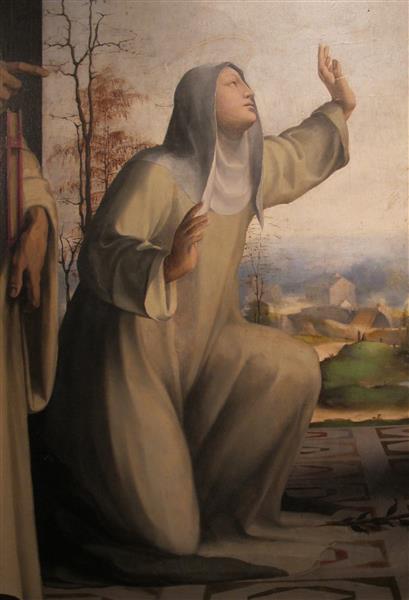










Following a pilgrimage to the Holy Land, Gaudentius was consecrated bishop for the See of Brescia in Italy by S. Ambrose, Bishop of Milan, around the year AD 387 (the same year that Ambrose baptised Augustine of Hippo). The best known of Gaudentius' sermons are those he gave to the newly baptized in the week following Easter, explaining directly and simply the real meaning of the sacraments. Gaudentius died around AD 410, the year of the sack of Rome by Alaric the Visigoth. The paragraphs below, from his exposition of the Eucharistic Sacrifice, are set to be read in today’s Office of Readings.
The heavenly sacrifice, instituted by Christ, is the most gracious legacy of his new covenant. On the night he was delivered up to be crucified he left us this gift as a pledge of his abiding presence.
This sacrifice is our sustenance on life’s journey; by it we are nourished and supported along the road of life until we depart from this world and make our way to the Lord. For this reason he addressed these words to us: Unless you eat my flesh and drink my blood, you will not have life in you.
It was the Lord’s will that his gifts should remain with us, and that we who have been redeemed by his precious blood should constantly be sanctified according to the pattern of his own passion. And so he commanded those faithful disciples of his whom he made the first priests of his Church to enact these mysteries of eternal life continuously. All priests throughout the churches of the world must celebrate these mysteries until Christ comes again from heaven. Therefore let us all, priests and people alike, be faithful to this everlasting memorial of our redemption. Daily it is before our eyes as a representation of the passion of Christ. We hold it in our hands, we receive it in our mouths, and we accept it in our hearts.
It is appropriate that we should receive the body of Christ in the form of bread, because, as there are many grains of wheat in the flour from which bread is made by mixing it with water and baking it with fire, so also we know that many members make up the one body of Christ which is brought to maturity by the fire of the Holy Spirit. Christ was born of the Holy Spirit, and since it was fitting that he should fulfil all justice, he entered into the waters of baptism to sanctify them. When he left the Jordan he was filled with the Holy Spirit who had descended upon him in the form of a dove. As the evangelist tells us: Jesus, full of the Holy Spirit, returned from the Jordan.
Similarly, the wine of Christ’s blood, drawn from the many grapes of the vineyard that he had planted, is extracted in the wine-press of the cross. When men receive it with believing hearts, like capacious wineskins, it ferments within them by its own power.
And so, now that you have escaped from the power of Egypt and of Pharaoh, who is the devil, join with us, all of you, in receiving this sacrifice of the saving passover with the eagerness of dedicated hearts. Then in our inmost being we shall be wholly sanctified by the very Lord Jesus Christ whom we believe to be present in his sacraments, and whose boundless power abides for ever.
 The members of some Eastern sect or secret society or other seemed to have made a scene somewhere; nobody could imagine why. One incident occurred once or twice again and began to arouse irritation out of proportion to its insignificance. It was not exactly what these provincials said; though of course it sounded queer enough.
The members of some Eastern sect or secret society or other seemed to have made a scene somewhere; nobody could imagine why. One incident occurred once or twice again and began to arouse irritation out of proportion to its insignificance. It was not exactly what these provincials said; though of course it sounded queer enough.